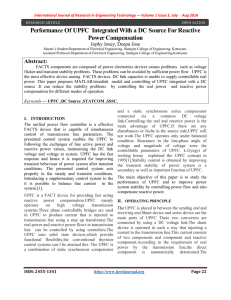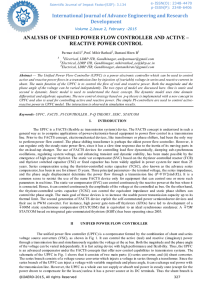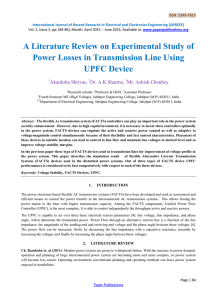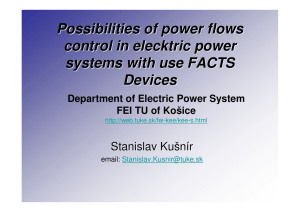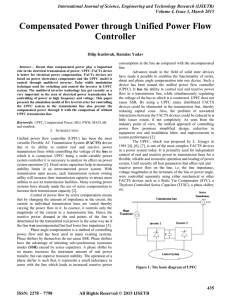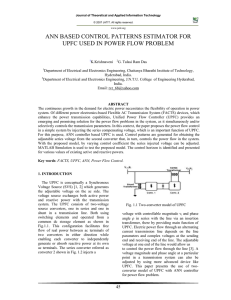UPFC Power Flow Control in Transmission Systems
advertisement
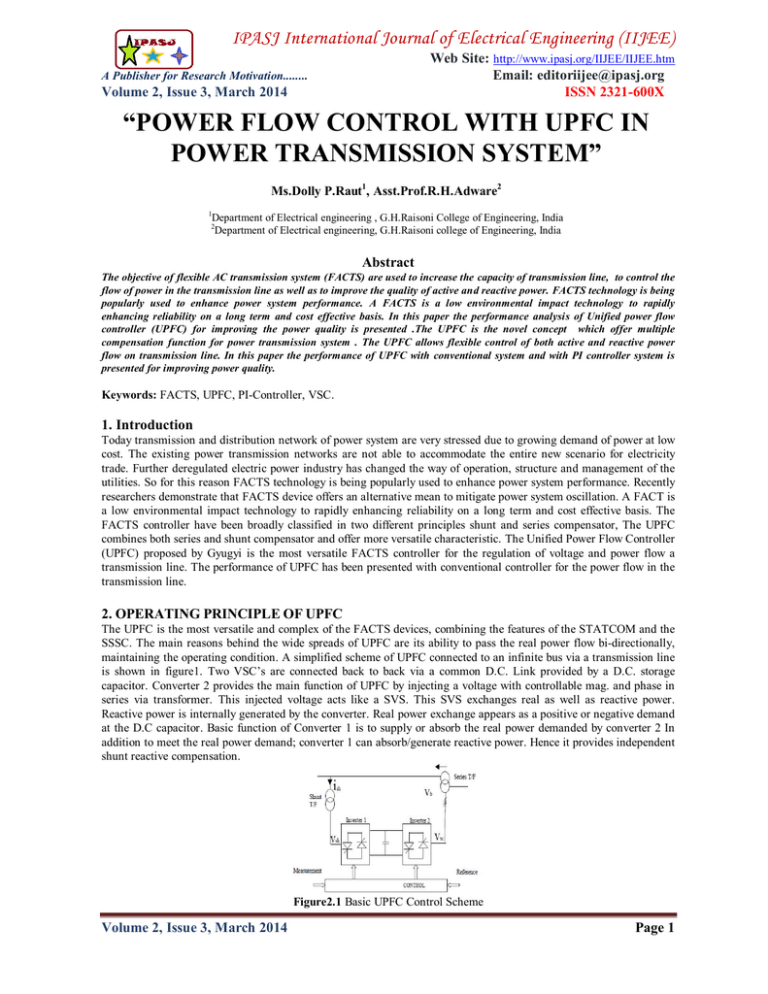
IPASJ International Journal of Electrical Engineering (IIJEE) Web Site: http://www.ipasj.org/IIJEE/IIJEE.htm Email: editoriijee@ipasj.org ISSN 2321-600X A Publisher for Research Motivation........ Volume 2, Issue 3, March 2014 “POWER FLOW CONTROL WITH UPFC IN POWER TRANSMISSION SYSTEM” Ms.Dolly P.Raut1, Asst.Prof.R.H.Adware2 1 Department of Electrical engineering , G.H.Raisoni College of Engineering, India Department of Electrical engineering, G.H.Raisoni college of Engineering, India 2 Abstract The objective of flexible AC transmission system (FACTS) are used to increase the capacity of transmission line, to control the flow of power in the transmission line as well as to improve the quality of active and reactive power. FACTS technology is being popularly used to enhance power system performance. A FACTS is a low environmental impact technology to rapidly enhancing reliability on a long term and cost effective basis. In this paper the performance analysis of Unified power flow controller (UPFC) for improving the power quality is presented .The UPFC is the novel concept which offer multiple compensation function for power transmission system . The UPFC allows flexible control of both active and reactive power flow on transmission line. In this paper the performance of UPFC with conventional system and with PI controller system is presented for improving power quality. Keywords: FACTS, UPFC, PI-Controller, VSC. 1. Introduction Today transmission and distribution network of power system are very stressed due to growing demand of power at low cost. The existing power transmission networks are not able to accommodate the entire new scenario for electricity trade. Further deregulated electric power industry has changed the way of operation, structure and management of the utilities. So for this reason FACTS technology is being popularly used to enhance power system performance. Recently researchers demonstrate that FACTS device offers an alternative mean to mitigate power system oscillation. A FACT is a low environmental impact technology to rapidly enhancing reliability on a long term and cost effective basis. The FACTS controller have been broadly classified in two different principles shunt and series compensator, The UPFC combines both series and shunt compensator and offer more versatile characteristic. The Unified Power Flow Controller (UPFC) proposed by Gyugyi is the most versatile FACTS controller for the regulation of voltage and power flow a transmission line. The performance of UPFC has been presented with conventional controller for the power flow in the transmission line. 2. OPERATING PRINCIPLE OF UPFC The UPFC is the most versatile and complex of the FACTS devices, combining the features of the STATCOM and the SSSC. The main reasons behind the wide spreads of UPFC are its ability to pass the real power flow bi-directionally, maintaining the operating condition. A simplified scheme of UPFC connected to an infinite bus via a transmission line is shown in figure1. Two VSC’s are connected back to back via a common D.C. Link provided by a D.C. storage capacitor. Converter 2 provides the main function of UPFC by injecting a voltage with controllable mag. and phase in series via transformer. This injected voltage acts like a SVS. This SVS exchanges real as well as reactive power. Reactive power is internally generated by the converter. Real power exchange appears as a positive or negative demand at the D.C capacitor. Basic function of Converter 1 is to supply or absorb the real power demanded by converter 2 In addition to meet the real power demand; converter 1 can absorb/generate reactive power. Hence it provides independent shunt reactive compensation. Figure2.1 Basic UPFC Control Scheme Volume 2, Issue 3, March 2014 Page 1 IPASJ International Journal of Electrical Engineering (IIJEE) A Publisher for Research Motivation........ Volume 2, Issue 3, March 2014 Web Site: http://www.ipasj.org/IIJEE/IIJEE.htm Email: editoriijee@ipasj.org ISSN 2321-600X 3. EQUIVALENT MODEL OF UPFC Equivalent model of UPFC is shown in Fig3.1. In the Equivalent model of UPFC a voltage source is connected in series with the transmission line for representing series converter and a current source is connected in shunt for representing shunt converter. The waveforms of Active and reactive power is shown in figure3.2. From the waveforms obtained through simulation of equivalent model of UPFC, the results are tabulated as shown in table3.3 [1]. From that table it is observed that the Active and reactive power of the power system can be control by controlling the phase angle of series injected voltage. Figure3.1 Equivalent model of UPFC Figure3.2 Waveforms of Active and reactive Powers 4. UPFC I. Conventional Method Two bus system of UPFC is shown in Fig4.1.Voltage across load 1 and load2 is shown in fig4.2a.Active and reactive powers waveforms is shown in figure 4.2b.Load2 which is initially in OFF condition and it is switch ON at t=0.3sec,the shunt branch of UPFC is always in ON condition, whereas the series branch of UPFC is switched ON at t=0.4sec.So time taken for switching is 0.1sec. Figure4.1 Two bus system of UPFC Volume 2, Issue 3, March 2014 Page 2 IPASJ International Journal of Electrical Engineering (IIJEE) A Publisher for Research Motivation........ Volume 2, Issue 3, March 2014 Web Site: http://www.ipasj.org/IIJEE/IIJEE.htm Email: editoriijee@ipasj.org ISSN 2321-600X Figure.4.2a waveforms of Voltage across Load1 and Load2 Figure4.2b Waveforms of Active and reactive Powers II. MODEL OF UPFC WITH PI-CONTROLLER A UPFC is used with PI controller to improve the power quality by reducing the sag period and peak value of voltage. A PI Controller is used for closed loop based UPFC system. In figure4.2a the PI-controller is used with UPFC to improve the Active and Reactive power in the system. Waveforms of voltage across load 1 and load 2 is shown in the figure 4.2b, whereas the waveforms of Active and reactive power is in figure 4.2c. Comparison of Open loop and Closed loop based UPFC system is shown in table4.2d. The PI-Controller output is given by, Kp +Ki ∫∆dt Figure4.1aModel of UPFC with PI-Controller Volume 2, Issue 3, March 2014 Page 3 IPASJ International Journal of Electrical Engineering (IIJEE) A Publisher for Research Motivation........ Volume 2, Issue 3, March 2014 Web Site: http://www.ipasj.org/IIJEE/IIJEE.htm Email: editoriijee@ipasj.org ISSN 2321-600X Fig.4.2b waveforms of Voltage across Load1 and Load2 Figure4.2c waveforms of active and reactive power Table 4.2d: Comparison of Open loop and Closed loop Based UPFC system Controller UPFC Open loop Sag Period in (sec) 0.1 UPFC with PI-Controller 0.02 5. CONCLUSION: This paper presents a platform that can be used for FACTS controller studies. In the Simulation study, MATLAB simulink environment is used to simulate the model of UPFC. This paper presents the performance analysis of UPFC for improving the power quality in the conventional system and PI controller system. Simulation results show the effectiveness of the UPFC to control active and reactive powers. It has been found that there is reduction in the switching period and reduction in the value of the peak voltage during the switching period. Analysis shows that UPFC with PI controller improves the power quality in the power system. The platform can be extended to study the advance controller with UPFC for improving power quality References [1] S.Muthukrishnan et al., “Performance evaluation of fuzzy logic and PI controller Based UPFC for Power quality improvement,” European Journal of Scientific Research ISSN 1450-216X Vol. 88 No 2 October, 2012, pp.277284. [2] S. Tara Kalyani, G. Tulasiram Das, (2008) „Simulation of real and reactive power flow with UPFC connected to a transmission line‟, Journal of Theoretical and Applied Information Technology [3] Khadkikar, V., Aganval, P., Chandra, A., Bany, A.O. and Nguyen, T.D. (2004) „A simple new control technique for unified power quality conditioner (UPQC)‟, 11th International Conference on Harmonics and Quality of Power, Lake Placid, NewYork, USA, Sept 12-15,pp.289– 293. [4] R.Mihalic et al., “Improvement of transient stability using unified power flow controller‟ IEEE Trans.Power Del., vol. 11, no. 1, pp. 485-492, Jan 1996 Volume 2, Issue 3, March 2014 Page 4 IPASJ International Journal of Electrical Engineering (IIJEE) A Publisher for Research Motivation........ Volume 2, Issue 3, March 2014 Web Site: http://www.ipasj.org/IIJEE/IIJEE.htm Email: editoriijee@ipasj.org ISSN 2321-600X [5] C.D. Schaulder et al., “Operation of unified power flow controller (UPFC) under practical constraints‟, IEEE Trans.Power Del., vol.13, no.2. pp. 630-639, Apr1998 [6] N.G. Hingorani, Flexible AC transmission, IEEE Spectrum (1993) 40–45. [7] L. Gyugyi, A unified power flow control concept for flexible AC transmission systems, IEE Proc. Gener. Transm. Distrib. 139 (4) (1992) 323–331 [8]Narain G. Hingaroni and Laszlo Gyugi, Understanding Facts, Concepts and Technology of Flexible AC Transmission system, IEEE press, 2001. [8] K.R.Padiyar, “FACTS Controller in transmission and distribution” [9] HINGORANI, N.H.: ‘Flexible AC transmission systems’, IEEE Spectrum, 1993, pp.40-45 AUTHOR Dolly P.Raut Completed my degree in the year 2011 from A.C.E.T and pursuing M.tech from G.H.Raisoni College of engineering,Nagpur Volume 2, Issue 3, March 2014 Page 5

